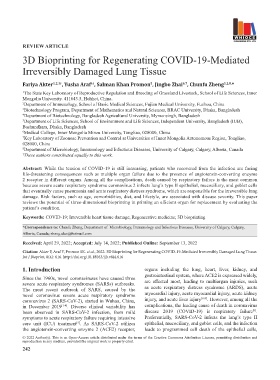Page 250 - IJB-8-4
P. 250
REVIEW ARTICLE
3D Bioprinting for Regenerating COVID-19-Mediated
Irreversibly Damaged Lung Tissue
Fariya Akter 1,2,3† , Yusha Araf , Salman Khan Promon , Jingbo Zhai , Chunfu Zheng 1,2,8, *
6,7
5
4†
1 The State Key Laboratory of Reproductive Regulation and Breeding of Grassland Livestock, School of Life Sciences, Inner
Mongolia University. 411643.5, Hohhot, China.
2 Department of Immunology, School of Basic Medical Sciences, Fujian Medical University, Fuzhou, China
3 Biotechnology Program, Department of Mathematics and Natural Sciences, BRAC University, Dhaka, Bangladesh
4 Department of Biotechnology, Bangladesh Agricultural University, Mymensingh, Bangladesh
5 Department of Life Sciences, School of Environment and Life Sciences, Independent University, Bangladesh (IUB),
Bashundhara, Dhaka, Bangladesh
6 Medical College, Inner Mongolia Minzu University, Tongliao, 028000, China
7 Key Laboratory of Zoonose Prevention and Control at Universities of Inner Mongolia Autonomous Region, Tongliao,
028000, China
8 Department of Microbiology, Immunology and Infectious Diseases, University of Calgary, Calgary, Alberta, Canada
† These authors contributed equally to this work.
Abstract: While the tension of COVID-19 is still increasing, patients who recovered from the infection are facing
life-threatening consequences such as multiple organ failure due to the presence of angiotensin-converting enzyme
2 receptor in different organs. Among all the complications, death caused by respiratory failure is the most common
because severe acute respiratory syndrome coronavirus 2 infects lung’s type II epithelial, mucociliary, and goblet cells
that eventually cause pneumonia and acute respiratory distress syndrome, which are responsible for the irreversible lung
damage. Risk factors, such as age, comorbidities, diet, and lifestyle, are associated with disease severity. This paper
reviews the potential of three-dimensional bioprinting in printing an efficient organ for replacement by evaluating the
patient’s condition.
Keywords: COVID-19; Irreversible heart tissue damage; Regenerative medicine; 3D bioprinting
*Correspondence to: Chunfu Zheng, Department of Microbiology, Immunology and Infectious Diseases, University of Calgary, Calgary,
Alberta, Canada; zheng.alan@hotmail.com
Received: April 29, 2022; Accepted: July 14, 2022; Published Online: September 13, 2022
Citation: Akter F, Araf Y, Promon SK. et al., 2022. 3D Bioprinting for Regenerating COVID-19-Mediated Irreversibly Damaged Lung Tissue.
Int J Bioprint, 8(4): 616. http://doi.org/10.18063/ijb.v8i4.616
1. Introduction organs including the lung, heart, liver, kidney, and
gastrointestinal system, where ACE2 is expressed widely,
Since the 1960s, novel coronaviruses have caused three are affected most, leading to multiorgan injuries, such
severe acute respiratory syndromes (SARSs) outbreaks.
The most recent outbreak of SARS, caused by the as acute respiratory distress syndrome (ARDS), acute
novel coronavirus severe acute respiratory syndrome myocardial injury, acute myocardial injury, acute kidney
coronavirus 2 (SARS-CoV-2), started in Wuhan, China, injury, and acute liver injury [6-8] . However, among all the
in December 2019 [1-4] . Diverse clinical variability has complications, the leading cause of death in coronavirus
[9]
been observed in SARS-CoV-2 infection, from mild disease 2019 (COVID-19) is respiratory failure .
symptoms to acute respiratory failure requiring intensive Preferentially, SARS-CoV-2 infects the lung’s type II
care unit (ICU) treatment . As SARS-CoV-2 utilizes epithelial, mucociliary, and goblet cells, and the infection
[5]
the angiotensin-converting enzyme 2 (ACE2) receptor, leads to programmed cell death of the epithelial cells,
© 2022 Author(s). This is an Open-Access article distributed under the terms of the Creative Commons Attribution License, permitting distribution and
reproduction in any medium, provided the original work is properly cited.
242

